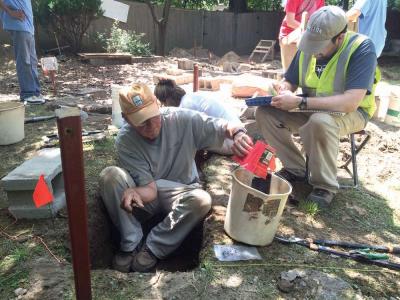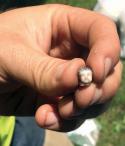July 16, 2015

White porcelain buttons, pieces of writing slates, clay marbles, and the head of a “Frozen Charlotte” doll. These are some of the artifacts that have been unearthed in recent days at a city-sponsored archaeological dig at the site of a former girls reform school on Centre Street.
The Epiphany School, which owns the property at 232 Centre St., planned to demolish the old Industrial School for Girls building as part of an expansion project. Instead, the school worked with the Boston Landmarks Commission and decided to restore the historic building. As part of their collaboration, the city commission is combing the grounds to uncover the unwritten story and lives of the 19th century girls who lived at and attended the school.
Led by City Archaeologist Joseph Bagley, volunteers, young people from the Community Dream Team program offered through the mayor’s Department of Youth Engagement and Employment, and current students at the Epiphany School are digging in the building’s yard to locate artifacts and the remnants of former structures, specifically a carriage house and outbuilding. The dig started on July 6. Eight days later, on Tuesday, the foundation of the carriage house was exposed.
Founded in 1859, the Industrial School for Girls was built to house and educate between 15 to 30 girls, most between the ages of 6 and 15.
Though not technically a reform school, the actual circumstances in which a girl was sent to the school are somewhat vague,” said Bagley. “It was almost a reformatory but not quite. Girls were sometimes sent in due to having a single parent or alcoholism in their family, while sometimes the girls had physical handicaps. They were not brought here as punishment, but more of as a preemptive strike.”
In addition to finding artifacts of the 19th-century training in “Victorian domestic arts,” Bagley hopes to find examples of the girls’ resistance to that curriculum as well. “They were being trained into tea services, house cleaning, sewing, but they were also probably rebelling,” he said. “We are hoping to find stuff from their Victorian house training as well as their reactions to that. Maybe we are finding alcohol bottles or medicine bottles that could have been used as alcohol, or tobacco products that would probably been banned. We want to find both sides of that.”
Mattapan’s Jalen Campbell, 19, is a member of the Community Dream team and a student at Curry College. “I’m a history major, so I jumped at the opportunity to work here. Every time I dig or sift, I say to myself that I’m discovering new history every day. And,” he said,” I get to feel like Indiana Jones.
 Doll head
Doll head
For Bagley, the dig is a rare archaeological opportunity due to the highly specific nature of the site’s history. “Unlike most digs, we have a very narrow focus site,” said Bagley. “We have only one gender, which never happens. We have one age group, 6 to 15, and the school is the only thing that was ever here. We don’t have a lot of things piled under or on top of the site, so everything we find is from the girl’s school.”
The project is also a chance to learn about a group of Bostonians who, other than their names, have been lost to history.
“It’s not just the preservation of the city’s history, it’s finding the rest of it. There’s a lot that happened in the past that just doesn’t get written down, doesn’t get preserved in the buildings that we still have in Boston. So much of the people of Boston’s history just doesn’t get recorded,” said Bagley. “We use archaeology to find the other story. These are girls that never made it into the historical record; we only know their names. We are hoping to get more information on what it was like to be a girl in Dorchester in 1859, 1860, living in this house, somewhat against their will, and being forced to train in Victorian lifestyles.”
Photos and live updates from the dig can be followed on the City Archaeology Program media pages including Facebook at facebook.com/bostonarchaeologyprogram and on Twitter or Instagram at @bostonarchaeo.


